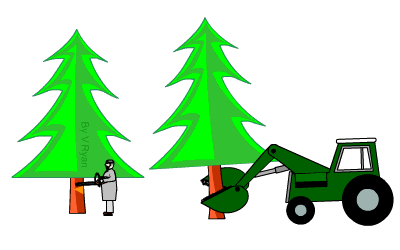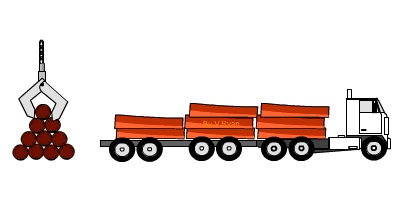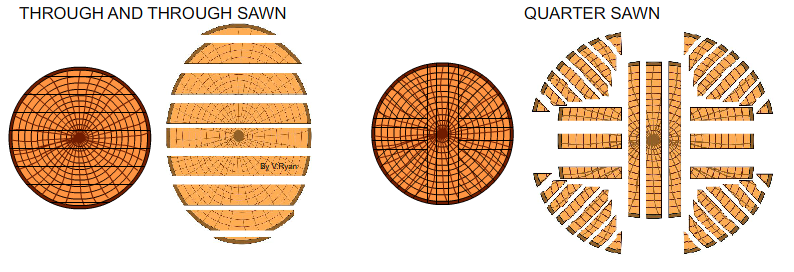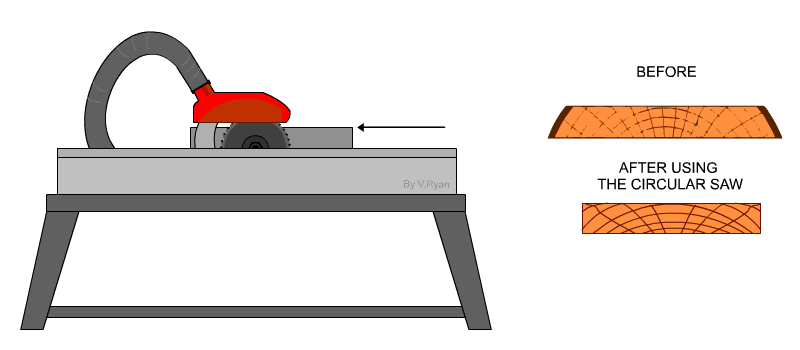| CLICK HERE FOR INDEX PAGE | |
| PREPARATION OF TIMBER FOR COMMERCIAL USE - 1 | |
| V. Ryan © 2011 | |
|
STAGE ONE: The ‘felling’ of a tree, is the first stage of preparing the timber for commercial use. This is normally carried out in winter, when the tree has less moisture content. In the summer months, trees can have more then fifty percent water content. This increased weight adds to the cost of transport, handling and initial preparation for the sawmill. Even in winter, trees have a high water content. |
|
 |
Mature trees are selected by a forestry worker. Only older trees are
chosen, allowing the younger trees to grow to maturity. Felled trees are
replaced with saplings. Consequently, the forest is sustainable (it should
not run out of trees). If small numbers of trees are harvested each day, a skilled forestry worker will use a chainsaw. When high numbers of trees are to be harvested, a team of forestry workers will work together felling trees. Alternative, in large forests, such as in Norway, specially designed ‘tractors’ with cutters and grabbers, will be used to fell hundreds of trees in one day. |
 |
STAGE TWO: The tree trunks (logs) are stored / stacked in a clearing. Sometimes logs are stored in the forest until they are needed at the sawmill. This also allows some of the ‘free’ water content to evaporate, reducing the weight of the tree / log. |
 |
STAGE THREE: The logs are transported to the sawmill, using vehicles equipped with lifting gear. In the Tropics, large numbers of logs are transported by floating them in rivers and allowing them to be carried down stream by the current, to sawmills. |
| STAGE FOUR: At the sawmill, the logs are cut into ‘boards’ using equipment such as circular saws and bandsaws. This is called ‘conversion’. The first stage of conversion is a process called ‘breaking down’, which means rough sawing. The second stage is called ‘resawing’ and refers to more accurate / precise cutting and finishing, such as planing and further machining. Two types of rough sawing for the breaking down process, are shown below. |
|
 |
|
 |
|
| Large circular saws are then used to further process the boards, removing the curved edges. Each processed piece of wood now looks like a board. | |
 |
|
| STAGE FIVE: WHAT IS SEASONING AND WHY IS IT NECESSARY? | |
| When a tree is felled, it
contains a large proportion of water / moisture. Many felled trees have
forty to fifty percent water content. Seasoning of natural wood, is the
process through which excess water / moisture is removed, leaving
typically fifteen to twenty percent water content. Wood that has not been seasoned and still has a high water content is called ‘green wood’. Wood that has had its water content reduced is called ‘seasoned wood’. Water is held inside a tree in two ways. ‘Free Water’ is water that is held in the vessels and cells and its purpose is to distribute nutrients inside the tree. ‘Cell’ water (also known as ‘bound’ water), is an intrinsic part of the tree’s cell walls. During the seasoning process a tree loses its ‘free’ water and a high proportion of its ‘cell’ / ‘bound’ water. Seasoned wood is used to make furniture and most other wood based products, because it is less likely to ‘deform’ and ‘warp’. It can be shaped accurately with tools such as planes, saws, routers and hand tools. Adhesives can also be used with seasoned woods. On the other hand ‘green wood’ (unseasoned wood), has a tendency to warp and change shape, making it difficult to make precise products. Working with green wood is a skilled craft in its on right, requiring years of training and dedication. |
|
| CLICK HERE FOR RESISTANT MATERIALS INDEX PAGE | |